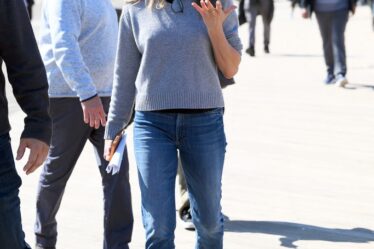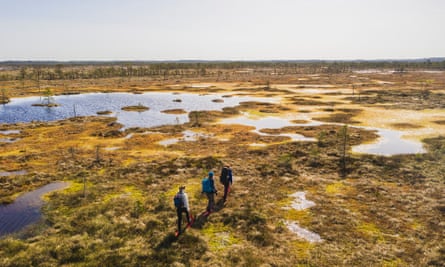
Finland: Watching bears, owls and wolves in lakeland
A six-and-a-half-hour train ride from Helsinki, the town of Kajaani is the unofficial capital of Finland’s Lakeland region. The number of perfectly serene bodies of water here, ripe for paddleboarding, kayaking and myriad watersports, easily outnumber the settlements dotted between them.
But it’s not the waters that offer the wildest experience. In the woodlands to the east, European brown bears roam in multitudes. Surveys conducted in 2019 put the population of these relatives of the North American grizzly at around 2,000. A number of bear hides can be hired for watching them eat, court and play.
The Bear Centre is located in a wilderness area called Vartius, just over a mile from the Russian border (where many of the bears roam in from). Guests can safely wander the marked trails by day – birdwatching possibilities from hides abound, with multiple species of owl, eagles, woodpeckers and curious blue jays spotted regularly.
Then, by night, everyone follows a guide to decamp to their own personal hide and watches the bears emerge from the trees (stay for just one night or several). June and July bring long hours of daylight for photo ops; August and September offer the best chance to see mothers with their cubs; and October brings with it early snow. Wolverines and wolves often put in an appearance too.
The hides range from very basic with a mattress on a bunkbed (though these are the best for photography as they have special openings for unhindered shots) to the luxurious, with huge picture windows, central heating, a kitchenette and shower, plus an audio system so you can hear the sounds of the forest. From €99 per person.
Estonia: Bog hiking, swimming and wild camping
Just 40 miles, or an hour’s drive, east of Tallinn – the capital famed for its Christmas markets and stag parties – is a landscape brimming with (literally) bucketloads of wild water. Part of Kõrvemaa nature reserve, Kõnnu Suursoo is one of Estonia’s “boglands”, swathes of wilderness pockmarked by mineral-rich lakes, edged by forests of indigenous European white elm, ash and maple, and covered with a carpet of sphagnum moss.
Boardwalks and pathways allow safe passage across the quagmire, but a guide can be hired (try Prangli Travel) who will supply special “bog shoes” (basically, snowshoes) and lead walkers off paths into miniature woodlands, where hardy trees more than 20 years old are still only the height of a ruler.
It’s worth taking a local along for the stories alone – these landscapes are said to be the home of an abundance of spirits – such as Hiid, Hero of the Forest, who watches over visitors from the treetops, and Allikaravitseja, Elf of the Springs, who appears in the reflections of the water to bless only the kindest people.
Swimming in these natural pools is possible too year-round (although they can be frozen in the winter). The geological make-up is believed to do wonders for the skin, and the cool temperature is exhilarating for the soul. Foraging is easy, with bilberry, cranberries and chanterelle mushrooms found in spring, summer and autumn.
Within walking distance to Kõnnu Suursoo bog is Järvi Päarnjarvi campsite, which is free to use and offers benches and fire pits, so there’s a chance to warm up after days spent swimming, walking and storytelling.
For a multi-day adventure, soomaa.com offers bogshoe tours and canoe trips in all five seasons (the fifth is the “flood” season).
Spain: Cycling on the trail of Iberian lynx in Andalucía
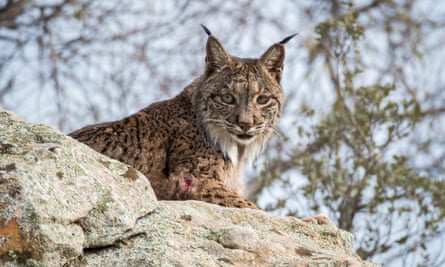
Less than an hour’s drive from Seville (or a four-hour cycle) is Andalucía’s Coto Doñana national park. Comprising around 20 miles of white sand beaches, undulating dunes, pockets of woodland and a smattering of saltmarsh, it is an untamed mosaic of terrain.
Amid its varied habitats are woodlarks, warblers, shrikes and bee-eater birds, fallow and red deer, wild boars, Egyptian mongoose and one of the most endangered feline species in the world – the Iberian lynx. Sporting what looks like a white beard and elongated black tufts from the tips of its ears, a few years ago it was estimated there were only 100 of these cats left in the wild. Conservation projects have made some progress; even so, there are still only about 400 today – and this national park is one of the best places to attempt to see them. They are elusive, so a guided wildlife-watching tour (Discovering Doñana offers small-group day trips from €50 per person) is recommended to at least get oriented and familiar with the lynx’s habitat.
The best way to explore is on two wheels (Bike Tour Doñana, a couple of miles outside the park, offers a range of bikes) and there are several tracks to choose from, including the 10-mile Asperillo trail, which takes in reforested umbrella pine and myriad opportunities to stop and watch for birds; the 40-mile Guadalquivir Marshes trail, which offers gravel tracks amid the marshes with an overnight break possible in El Rocío; and the 15-mile Vereda del Loro, that will take you to the in-park campsite (a good place to base yourself).
For those who prefer hiking there are plenty of walking routes – from short, one-milers to full-day, 10-mile wanders across different areas of the park (info available from one of the many visitor centres) – and there’s even a boat from Sanlúcar de Barrameda to Poblado de la Plancha for a watery exploration.
Accommodation abounds in the marsh-adjacent village of El Rocío with budget camping, pensions and hotels, starting from around €25 a night. Other options can be found in the more urban beachside resort of Matalascañas.
Portugal: Rewilding in the Greater Côa valley
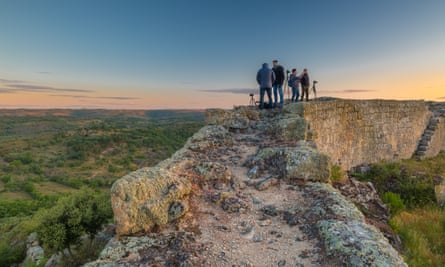
Criss-crossed by deep river valleys, patchworked with oak forests and swathes of rocky heathland, the Greater Côa valley in Portugal’s north-east is slowly changing. Since 2019, this region – between the mighty Douro river and the tree-covered Malcata mountains – has been in the care of non-profit organisation Rewilding Portugal, with the aim of creating a cross-border wildlife corridor with neighbouring Spain.
after newsletter promotion
Since it began, there have been many successes, including the discovery of both a black and griffon vulture colony; the release of 10 semi-wild Sorraia horses into the area to increase natural grazing, thereby reducing wildfire risk; and the training of locals as nature guides to ensure both visitors and the community who live around the valley benefit from the rewilding initiative.
A great way to explore the valley is by walking the Grande Rota do Côa, a 138-mile trail that follows the length of the Côa river from its headwaters near Spain (south-west of the small town of Soito) to the Côa Museum – where this river meets the Douro. The walk is divided into 11 stages, and along the way there are numerous villages to stay in. Wildlife-spotting opportunities include wild boar, red and roe deer, birds such as raptors and vultures, and a small pack of Iberian wolves.
Rewilding Europe Travel – a specialist in rewilding project trips – has a five-day trip (from €645), with local expert naturalists, to showcase the subtle changes and bold plans that are happening in the valley.
France: Donkey hikes on ancient mule tracks in the Ardèche
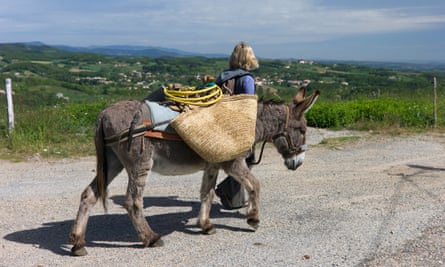
In the south of France, equidistant from Montpellier and Marseille on the Mediterranean coast, are the limestone cliffs, tree-lined slopes and water-carved gorges of a region sculpted by nature – the Gorges de l’Ardèche.
Running between this canyon’s amphitheatre of rocky caverns and its namesake long, winding river, is the GR4 – one of the country’s famous hiking trails. Many will walk the 71-mile section of it here in four days, staying in B&Bs or campsites en route, as it undulates up and over the Massif Central towards the pre-alpine Vercors.
But in addition to the walking route, the region is traced by hundreds of old mule tracks. Historically used as hardy transporters of goods from farms to towns, donkeys were once the lifeblood of this region. Over time, and the invention of roads and mechanised vehicles, their use saw a steady decline. Rather than lose a piece of their heritage, many owners in this region kept their loyal steeds, and now lend them to hikers who fancy walking at a much slower pace on the old network of paths – and have someone, or rather, something carry the bags.
Walking with a donkey is not a high-speed escapade, and it allows plenty of time to stop and appreciate the surroundings, making it a great adventure for families. Enjoy the wildflowers, bridges formed from weather-beaten stone, or one of the 2,000 caves that have been lived in by humans for thousands of years.
Accomodation options en route include a cheap and cheerful campsite on a farm, a cosy chambre d’hôte (B&B) or a hotel all set up with a paddock in which to leave a mule. The adventure is offered both as a group or a private, self-guided experience, and can be as long as a week or as short as a day, offered by locally run Trekane from €65.
Switzerland: A high-altitude walking ‘farm safari’

Cable cars are a familiar sight in the Swiss mountains, but away from slick modern versions (not to mention crowds) at many ski resorts is an entire network of much more rustic models – once vital to the farmers who work amid this vertiginous landscape.
Known in the local dialect as Buiräbähnli, they were, and occasionally still are, used to transport supplies up steep ascents. Now they have another purpose – forming a handy link in a circular walking route, named the Buiräbähnli Safari, a venture that aims to bring business to these small, high-altitude smallholds.
The concept is simple. After taking the train to Engelberg, walkers begin a 28-mile route through wild mountain landscapes, using eight of these cable cars to connect together mountain huts (for overnight stays) and farms (for feasting on local produce and hearty meals en route). There are no queues for a ride in this area of the mountains – the Buiräbähnli operate on a “request only” basis, and to catch one you have to pick up a phone inside the cabin/cable car, turn a handle and ask for it to be switched on and fired up. From there, it’s a high-level meander around lakes and through fields of wildflowers, up and over mountain passes and descents into small villages.
The farms on the trail range from meat and dairy to organic produce, and even a family-run venture where alpacas and llamas help children living in difficult circumstances. The Engelberg tourist board has a map and guide to accommodation and cable car passes.

